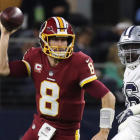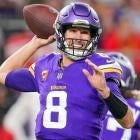Most players prefer a chance to test the open market over receiving a franchise player designation. The tag has been characterized as a high salaried one-year "prove it" deal, where the risk of serious injury and poor performance must be incurred again after completing a contract when a multi-year agreement can't be reached.
Redskins quarterback Kirk Cousins may be prompting players to reevaluate this thinking with his embrace of the designation. Playing on the tag in 2016 gave him a level of financial security where he could drive a really hard bargain this year when given the designation again for $23,943,600 as quarterback salaries escalated.
The franchise tag is also a powerful management tool that can prevent players from getting fair market value and generally depresses salaries. None of the edge rushers given franchise tags this year, Chargers defensive end Melvin Ingram, Cardinals linebacker Chandler Jones and Giants defensive end Jason Pierre-Paul, fared as well as Olivier Vernon did in 2016 as an unrestricted free agent. Vernon signed a five-year, $85 million contract containing $52.5 million in guarantees with the Giants. Jones came the closest on the five-year, $82.5 million deal with $53 million in guarantees he received from the Cardinals. Vernon's deal is also better structurally: $40 million of Vernon's money was fully guaranteed at signing and $54 million was fully guaranteed over the first three years. Jones' deal has $31 million fully guaranteed at signing and $51 million in the first three years.
Some important information about franchise tag logistics is below. The projected 2018 franchise numbers and an examination of the best candidates to receive the designation next year follow.
Franchise Tag Logistics
NFL teams can retain the rights to one of their impending free agents in 2018 with the use of a non-exclusive or an exclusive franchise tag during a 15-day period from Feb. 20 to March 6.
The way non-exclusive franchise tags are determined underwent a change with the 2011 Collective Bargaining Agreement. This franchise tag number had been an average of the five largest salaries in the prior year at a player's position or 120 percent of the prior year's salary of the player, whichever was greater, since its inception in 1993. For franchise tag purposes, salary means a player's salary cap number, excluding workout bonuses.
The 120 percent and five largest salaries provisions remain intact but the formula component is now calculated over a five year period that's tied to a percentage of the overall salary cap. More specifically, the number for each position is derived by taking the sum of the non-exclusive franchise tags as determined by the original methodology for the previous five seasons and dividing by the sum of the actual NFL salary cap amount for the previous five seasons. The resulting percentage, which is known as the Cap Percentage Average in the CBA, is then multiplied by the actual salary cap for the upcoming league year.

This non-exclusive tag allows a player to negotiate with other NFL teams but if he signs an offer sheet with another club, his team has five days to match the offer. If the offer is not matched, his team will receive two first round picks as compensation from the signing team.
Under the exclusive franchise tag, a player will receive a one-year offer from his team that is the greater of the average of the top five salaries at his position once the restricted free agent signing period of the current league year has ended (April 20 for 2018) or 120 percent of his prior year's salary. In the instances where the average of the top five salaries is controlling, the non-exclusive number is initially used as a placeholder then adjusted upwards if the exclusive calculation dictates once restricted free agency ends. A player cannot negotiate with other teams with the exclusive franchise tag.
Teams also have the option to apply a transition tag, which is seldom used, instead of a franchise tag. The transition tag operates similarly to the non-exclusive franchise tag, except it is based on the average of the top 10 salaries at a player's position. Teams have the same right of first refusal as with franchise tags but do not receive any draft choice compensation for declining to match an offer sheet.
2018 Franchise Tag Projections
The chart below contains an early look at the 2018 franchise tags. I keep track of the salary data necessary to do the calculations under the franchise tag formula. I recently confirmed with my NFL sources the 2017 data entering the formula. The franchise tags are preliminary because the numbers can't be finalized until the 2018 salary cap is set in late February or early March.
$180 million is being used for the 2018 salary cap. The 7.78 percent increase from the current $167 million figure is consistent with the growth in the salary cap in recent years.
Position | Current | Projected | % Change |
Cornerback | $14,212,000 | $15,212,000 | 7.04 |
Defensive End | $16,934,000 | $17,414,000 | 2.83 |
Defensive Tackle | $13,387,000 | $14,159,000 | 5.77 |
Linebacker | $14,550,000 | $15,197,000 | 4.45 |
Offensive Line | $14,271,000 | $14,299,000 | 0.2 |
Punter/Kicker | $4,835,000 | $5,017,000 | 3.76 |
Quarterback | $21,268,000 | $23,555,000 | 10.75 |
Running Back | $12,120,000 | $12,054,000 | -0.54 |
Safety | $10,896,000 | $11,465,000 | 5.22 |
Tight End | $9,780,000 | $10,001,000 | 2.26 |
Wide Receiver | $15,682,000 | $16,235,000 | 3.53 |
Note: Projections assume 2018 salary cap is $180 million.
Teams have become more judicious in using franchise player designations as the cost has increased. A record 21 players were franchised in 2012, including six kickers and punters, in the first year of the new method of calculation when there was almost a 20 percent across the board drop in the franchise tags from 2011. An average of seven players per year were given franchise tags over the last three years.
Best 2018 Candidates
Several players who would have received or been good candidates for franchise tags in 2018 have already signed contract extensions. These include Lions quarterback Matthew Stafford, Raiders quarterback Derek Carr, Texans wide receiver DeAndre Hopkins and Vikings cornerback Xavier Rhodes.
Saints quarterback Drew Brees and Patriots offensive tackle Nate Solder have clauses in their contracts preventing them from being designated as a franchise or transition player. Vikings quarterback Sam Bradford, Bengals tight end Tyler Eifert and Jaguars wide receiver Allen Robinson may have been franchise worthy without the significant injuries requiring surgery each sustained early in the season.
It is too cost prohibitive for the Seahawks to franchise tight end Jimmy Graham. The signing bonus proration from Graham's 2014 deal with the Saints, making him the NFL's first and only $10 million per year tight end, gets included under the 120 percent of the prior year's salary rules. This makes his franchise number $15.48 million.
The Rams aren't going to give cornerback Trumaine Johnson a franchise tag for a third straight year. A third franchise tag is the greater of the highest franchise number at any position, typically quarterback, 120 percent of the franchise number at a player's position or 144 percent of the player's prior season's salary. A 44 percent increase of Johnson's current $16,742,400 franchise number is $24,109,056.
Redskins president Bruce Allen indicated that designating Cousins as a franchise player in 2018 for a third and final time for $34,478,784 was a possibility, despite the steep cost, shortly after the quarterback rejected an offer reportedly worth $133 million over six years. This offer contained $72 million in overall guarantees, of which $53 million was fully guaranteed at signing.
Receiving another franchise tag will make continuing to go year-to-year before hitting free agency in 2019 extremely attractive unless the Redskins are willing to make him the NFL's highest paid player over Lions quarterback Matthew Stafford, who signed a five-year, $135 million contract extension with an NFL record $92 million of overall guarantees during the preseason. By rule, a third franchise tag would operate like Cousins' current exclusive one. He would be prevented from soliciting an offer sheet from other NFL teams. Another option is using a transition tag for $28,732,320, which would only give the Redskins a right to match another team's offer sheet.
Cousins has been one of the NFL's most productive quarterbacks statistically since becoming a full-time starter when the 2015 season began. He has completed 67.9 percent of his passes for 12,372 yards with 75 touchdowns and 31 interceptions to post a 99.4 passer rating. Cousins has the NFL's third-best completion percentage, is fourth in the NFL in passing yards, fifth in passer rating and eighth in touchdown passes since the start of the 2015 season.
There hasn't been a drop-off in Cousins' performance this season despite a higher degree of difficulty. The Redskins' offensive line has been decimated by injury. Cousins' rapport with the wide receivers isn't nearly as good after DeSean Jackson and Pierre Garcon went to the Buccaneers and 49ers in free agency. Additionally, he has had to adjust to a new play caller: former Redskins offensive coordinator Sean McVay is now a coach of the year candidate for his quick turnaround of the Rams.
Cousin could be a litmus test for quarterback salaries should he become an unrestricted free agent because quality passers in their prime almost never hit the open market. It's conceivable that Cousins could command $30 million per year with $100 million in guarantees if he is available in free agency market because there are more NFL teams than competent quarterbacks. Some of the quarterback needy teams, such as the Browns and Jets, will have an abundance of cap space in 2018.
It will cost $14.544 million, which is 120 percent of Bell's current $12.12 million salary, for Pittsburgh to place a second straight franchise tag on him in 2018. Bell, who leads the NFL with 1,057 rushing yards, has a legitimate shot to win his first rushing title. Bell is also solidifying his place as the best dual-threat running back in the game. His 1,559 yards from scrimmage are best in the league.
Bell rejected a contract offer the NFLPA reportedly found appropriate as the July 17 deadline for franchise players to sign multi-year deals neared. Multiple reports put the offer in the $60 million neighborhood for five years. The reports differed on other details of the offer. There was $39 million to $42 million over the first three years. Pittsburgh's offer was substantially more than the current $8.25 million per year benchmark held by the Falcons' Devonta Freeman in what has been a declining running back market. Bell was looking for at least $15 million per year to build upon the contract Adrian Peterson had been playing under since 2011, averaging approximately $14 million per year before the Vikings released him in the offseason. It remains to be seen whether Pittsburgh gets closer to Bell's demands after an All-Pro caliber season with an extremely heavy workload. His projected 448 touches (rushing attempts and receptions) would be the seventh most ever in a single season.
The 49ers made an unexpected move at the Oct. 31 trading deadline by acquiring Garoppolo, whose rookie contract expires after the season, from the Patriots for a 2018 second-round pick. The decision to wait a little more than a month after the trade to start Garoppolo, when he had a better grasp of the offense, was validated in his first extensive action. Garoppolo was impressive in leading the 49ers to a last-minute comeback victory over the Bears in Week 13. If Garoppolo's first start is a preview of things to come, a contract significantly more than the four-year, $72 million deal containing $37 million fully guaranteed the Texans gave Brock Osweiler as a free agent in 2016 will be in order.
Lawrence has impeccable timing. He is having a career year. Lawrence's 6.5 sacks in the first three games of the season helped him garner NFC Defensive Player of the Month honors for September. He is leading the NFL with 13.5 sacks. The Cowboys would be justified in having concerns about giving Lawrence a deal comparable to Olivier Vernon's with the Giants ($85 million over five years with $52.5 million in guarantees) because his 13.5 sacks in 12 games are 4.5 more than he had in the other 32 games of his NFL career spanning the previous three seasons.
Nobody was willing to pay Miami's steep price for what could have amounted to the league's most productive slot wide receiver playing just a handful of games when the Dolphins were reportedly open to moving Landry before the Oct. 31 trading deadline. Landry has already set the record for the most receptions during the first four seasons of an NFL career (368) with a quarter of a season left to add to that total. He may need to come to grips with the reality of the wide-receiver pay scale despite a historic reception rate if on the open market. Wide receivers that primarily thrive in the slot are typically paid less than those that excel on the outside or can take the top off opposing defenses.
Surprisingly, the Dolphins didn't approach Landry about a new deal during the offseason. Nonetheless, should the Dolphins engage in negotiations before free agency begins in mid-March, Landry would be justified in seeking significantly more than the five-year, $60 million contract Mike Wallace, who was a disappointment during his two years with Miami before being traded in 2015, received almost five years ago. Landry's future in Miami could hinge on 2015 first-round pick Devante Parker's development. Parker isn't having the breakout year that was expected.
The Vikings using a franchise or transition tag on Keenum seems implausible right now. It may become a realistic possibility if Keenum can continue to perform like a Pro Bowl quarterback instead of the journeyman backup he was presumed to be.
Nobody envisioned Keenum becoming an integral part of Minnesota's success when he signed a one-year, $2 million contract with $250,000 in incentives a month into free agency to back up Sam Bradford. Keenum has helped put the Vikings in contention to gain home-field advantage in the NFC for the playoffs with Bradford's ailing left knee limiting him to six quarters of action this season and 2014 first round pick Teddy Bridgewater, Minnesota's 2015 starting quarterback, recently returning from last preseason's devastating knee injury that put his career in jeopardy. Nine of Minnesota's 10 victories have come with Keenum under center.
Keenum is making it very difficult for head coach Mike Zimmer to switch quarterbacks despite Bridgewater's availability. In fact, Keenum has played the best football of his career since Bridgewater's return. He was named NFC Offensive Player of the Month for November after guiding the Vikings to a 3-0 record by completing 71.1 percent of his passes (69 of 97) for 866 yards with seven touchdowns and two interceptions to post a 114.0 passer rating.
Keenum would be very tempted to quickly accept a one-year transition tender, which should be $21.253 million with a $180 million 2018 salary cap. It would be more than three times the money he's made during his five years in the NFL.
Adams put his sophomore slump of 2015 behind him with a bounce-back 2016 campaign. He's become Green Bay's primary receiving threat this season over Jordy Nelson and Randall Cobb. He could have his first 1,000 receiving yard season despite two-time NFL MVP Aaron Rodgers being sidelined since breaking his right clavicle during a Week 6 contest against the Vikings.
Players that Green Bay wants to retain typically don't make it out of town. Keeping Adams will likely require more than the contracts Nelson and Cobb signed in 2014 and 2015, respectively, averaging in the $10 million per year neighborhood. Adams surely took note of the four-year, $52.25 million extension Alshon Jeffery just got from the Eagles. The last time the Packers used a franchise tag was in 2010 on defensive tackle Ryan Pickett, who promptly signed a long-term deal with the team.
Trading Garoppolo to the 49ers leaves Butler as New England's best candidate to get franchised. Butler has rebounded from a slow start to the season, which could be attributed to a tumultuous offseason. Cornerback Stephon Gilmore essentially got the money Butler wanted from the Patriots when he signed a five-year, $65 million deal with $40 million of guarantees in free agency. The Saints showed some interest in Butler, a restricted free agent, but weren't willing to sign the 2014 undrafted free agent to an offer sheet because giving up the 11th overall pick in the 2017 NFL draft was too big of a price to pay. Bill Belichick investing heavily in two cornerbacks would be out of character, particularly with Gilmore beginning to put the shaky start to his tenure in New England behind him.
A guard hasn't been franchised since the Patriots used the designation on Logan Mankins in 2011. This is because the franchise player system doesn't account for the salary differences at the three main offensive line positions (center, guard and tackle). Left tackles are the primary recipients of franchise tags.
The Panthers made Trai Turner, Norwell's counterpart at guard, a signing priority in the offseason. Turner received a four-year, $45 million extension with $20.5 million in guarantees. It will likely take a comparable contract to keep one of the NFL's best guard tandems from breaking up in 2018, since Norwell has been at least Turner's equal on the field over the last two seasons.
Norwell could be the next big beneficiary of the explosion in offensive guard salaries if on the open market. An unrestricted free agent has set the guard market in each of the last two years. In free agency, Norwell eclipsing the five-year, $60 million deal containing $31.5 million in guarantees Kevin Zeitler received from the Browns wouldn't be a surprise.
Richardson got the change in scenery that had been in the works for about a year with a trade to the Seahawks at the preseason-ending roster cutdown to 53 players. The Seahawks essentially gave a 2018 second-round pick and wide receiver Jermaine Kearse to the Jets for him.
Seahawks head coach Pete Carroll seems pleased in how Richardson is controlling the line scrimmage as a 4-3 defensive tackle, which is different than how the Jets used him in their 3-4 defense. The 2013 Defensive Rookie of the Year displayed his versatility with New York by lining up at various spots across the defensive line and at linebacker.
The well-documented off-the-field problems that plagued Richardson while with the Jets do not appear to have followed him to Seattle. Big-money defensive linemen haven't been a part of the equation in Seattle during the Carroll era. Making Richardson Seattle's highest paid defensive player, which is currently cornerback Richard Sherman at $14 million year, will probably be necessary to keep him in the fold. The five-year, $86 million contract with $53.5 million in overall guarantees Richardson's former defensive line-mate Muhammad Wilkerson received from the Jets in 2016 may be an important salary data point to him.
Extending Stafford's contract gives the Lions the option to franchise Ansah. The 2013 fifth overall pick demonstrated he can be one of the NFL's better pass rushers in 2015, when he was third in the NFL with 14.5 sacks. A nagging ankle injury derailed a 2016 season in which he only had two sacks. Ansah showed a glimpse of his 2015 form by collecting three sacks in Week 2's contest against the Giants but has been hampered by knee and back injuries. He has five sacks this season. The immense importance of players who can pressure opposing quarterbacks, which is supposed to be Ansah's strength, would be the main reason for tagging him.











































